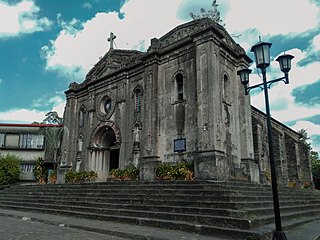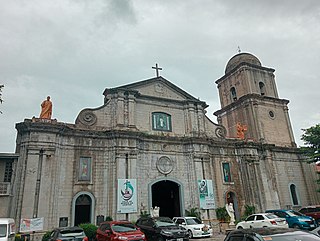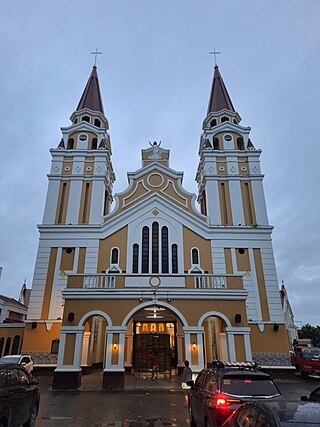
Anda, officially the Municipality of Anda, is a municipality in the province of Pangasinan, Philippines. According to the 2020 census, it has a population of 41,548 people.

Bani, officially the Municipality of Bani, is a municipality in the province of Pangasinan, Philippines. According to the 2020 census, it has a population of 52,603 people.

Bolinao, officially the Municipality of Bolinao, is a municipality in the province of Pangasinan, Philippines. According to the 2020 census, it has a population of 83,979 people.

Mabini, officially the Municipality of Mabini, is a municipality in the province of Pangasinan, Philippines. According to the 2020 census, it has a population of 26,454 people.

Pozorrubio, officially the Municipality of Pozorrubio, is a municipality in the province of Pangasinan, Philippines. According to the 2020 census, it has a population of 74,729 people.

The Order of Augustinian Recollects (OAR) is a mendicant Catholic religious order of friars and nuns. It is a reformist offshoot from the Augustinian hermit friars and follows the same Rule of St. Augustine. They have also been known as the "Discalced Augustinians".
Felipe Sonsong was a Philippine Jesuit. He was born to a noble family of Macabebe, Pampanga. Sonsong was the second Filipino Jesuit. He was married and had a son. After the death of his wife, he entered the Society of Jesus at the age of 57 as a donado and volunteered for the mission in the Marianas under Blessed Diego Luis de San Vítores. His superiors called him "the saintly Philippine" and noted that "(his) solid virtues were an example to his countrymen, and being a noble among his people, (he) is now, we believe, from his blameless life, a most noble citizen of the Realm of Heaven."

San Nicolas de Tolentino Parish Church is a Roman Catholic parish church in Quezon City, Philippines. It belongs to the Diocese of Cubao, under the Vicariate of Sto. Nino. The church is under the care of the Augustinian Recollect Province of Saint Ezequiél Moreno.

The Nuestra Señora de Gracia Church, commonly known as Guadalupe Church, is a Baroque Roman Catholic church in Makati City, Philippines. The parish church and its adjacent monastery are currently administered by the Archdiocese of Manila. The territory of the parish covers San Carlos Seminary, the major seminary of the Archdiocese of Manila and Our Lady of Guadalupe Minor Seminary. The church also has an adjacent seminary, the Monasterio de Guadalupe, which admits young professionals for priestly and religious vocation. The current parish priest is Rev. Fr. Joselito R. Martin.

The Augustinian Recollect Province of Saint Ezequiél Moreno is a division of the Order of Augustinian Recollects that has jurisdiction over the Philippines, Taiwan and Sierra Leone. It officially separated from the Province of Saint Nicholas de Tolentine on 28 November 1998. Today, the Provincialate House is located at the San Nicolas De Tolentino Parish Church on Neptune Street, Congressional Subdivision, Project 6, Quezon City.

Saints Peter and Paul Parish Church, commonly known as Calasiao Church, is a Baroque church located in Poblacion West, Calasiao, Pangasinan, Philippines. It belongs to the Vicariate of Sts. Peter and Paul under the Ecclesiastical Province of the Roman Catholic Archdiocese of Lingayen-Dagupan. The 57,840 Catholics is under the pastoral care of Rev. Fidelis B. Layog, assisted by Rev. Isidro Palinar, Jr. and Rev. Raymund Manaois.

The Santuario de San Juan Evangelista, also known as the Shrine of St. John the Evangelist or Dagupan Church, is a Roman Catholic church located along Jovellanos Street and Zamora Street, Dagupan, Pangasinan in the Philippines. It belongs to the Archdiocese of Lingayen-Dagupan.

The Diocesan Shrine and Parish of Our Lady of the Pillar, commonly known as Imus Cathedral, is a Roman Catholic cathedral church in the city of Imus, in the province of Cavite, Philippines. The church serves as the seat of the bishop of the Diocese of Imus, the diocese that has jurisdiction over the entire Civil Province of Cavite.

Saint Nicholas of Tolentino Parish Church, commonly known as Banton Church, is a Roman Catholic church in the municipality of Banton in Romblon province in the Philippines. It is under the jurisdiction of the Diocese of Romblon. The church is allegedly one of the oldest churches in the country, constructed between 1644 and 1650 during the Spanish colonial period. The façade and tower of the present church is Modern.

The Diocesan Shrine and Parish of San Andres, commonly known as Masinloc Church, is an 18th-century Baroque Roman Catholic church located at Brgy. South Poblacion, Masinloc, Zambales, Philippines. The parish church, dedicated to Saint Andrew the Apostle, is under the jurisdiction of the Diocese of Iba. The church structure, a standout among Spanish-era churches in the Central Luzon region for having been built with coral stone instead of adobe stone, was declared a National Cultural Treasure by the National Museum of the Philippines along with 25 other Spanish-era churches in 2001.

San Bartolome Parish Church, commonly known as Magalang Church, is a 19th-century Baroque Roman Catholic church located at Barangay San Nicolas I, Magalang, Pampanga, Philippines. The parish church, dedicated to Saint Bartholomew the Apostle, is under the Archdiocese of San Fernando.

The Metropolitan Cathedral of Our Lord's Transfiguration, also known as Transfiguration of Our Lord's Cathedral or simply Palo Cathedral, is a Roman Catholic church located at Palo, Leyte, in the Philippines belonging to the Vicariate of Palo under the Metropolitan Archdiocese of Palo.

Saint Joseph the Patriarch Cathedral Parish, commonly known as Alaminos Cathedral, is a Roman Catholic cathedral located at Barangay Poblacion in the city of Alaminos, Pangasinan, Philippines. Dedicated to Saint Joseph the Patriarch, it has been the episcopal seat of the Diocese of Alaminos since 1985.

Saint Augustine Cathedral Parish, commonly known as Iba Cathedral, is a cathedral parish of the Roman Catholic Church located in the municipality of Iba, Zambales, Philippines. It is dedicated to Saint Augustine of Hippo and is the episcopal seat of the Diocese of Iba which covers Zambales and Olongapo.

Luyag na Caboloan, known simply as Caboloan, alternatively as Binalatongan, was a sovereign pre-colonial Philippine polity (panarian) situated near the Agno River delta, centered around Binalatongan. It was reportedly the largest settlement in the entire Pangasinan region.






















